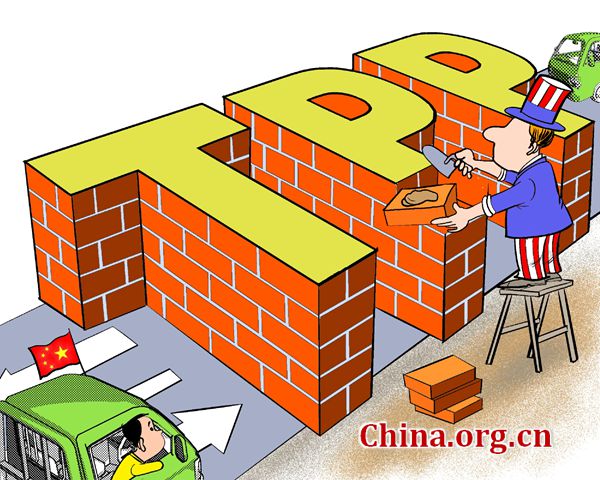TPP - a US 'slow growth' Pacific club
- By John Ross
 0 Comment(s)
0 Comment(s) Print
Print E-mail China.org.cn, November 14, 2015
E-mail China.org.cn, November 14, 2015
|
|
|
Trans-Pacific problematic [By Jiao Haiyang/China.org.cn] |
The character of the Trans-Pacific Partnership (TPP) becomes clear immediately after the fundamental economic data for its 12 intended signatory countries is examined. They are dominated by the G7 economies of the United States, Japan and Canada. These, together with Australia, constitute 90 percent of the GDP of potential signatories. Participating developing economies - Mexico, Malaysia, Chile, Vietnam and Peru - make up only 8 percent.
Figure 1 also shows that in 1985 economies in the proposed TPP accounted for 54 percent of world GDP while by 2014 this had dropped to 36 percent. The TPP therefore constitutes a group of advanced economies, with a "fringe" of developing countries, whose share in world GDP has been significantly declining.
|
Figure 1 |
 |
The percentage of world trade accounted for by potential TPP economies is substantially less than their combined weight in world GDP and is also falling - declining from 33 percent of world merchandise trade in 1984 to 25 percent in 2014. That the percentage of world trade accounted for by the TPP economies is significantly less than their percentage of world GDP shows this is a grouping of relatively "closed" economies in which trade plays a lower than average role. The TPP is therefore fundamentally different to the World Trade Organization which covered the overwhelming majority of world trade.
These trends contrast with China whose role in world GDP and trade has sharply increased but which the U.S. excluded from the TPP negotiations. What, therefore, was the U.S. rationale in creating a TPP of relatively closed economies with a declining weight in world GDP and trade?
The answer lies in trends in the U.S. economy. This dominates the TPP accounting for 62 percent of its GDP. The United States promotes a mythology that it is a dynamic economy but the reality is that the U.S. economy has been sharply slowing and its weight in the world economy declining. From 1984-2014 the U.S. share of world GDP fell from 34 percent to 23 percent, at current exchange rates, while the U.S. share of world merchandise trade dropped from 15 percent to 11 percent.




 Add your comments...
Add your comments...

